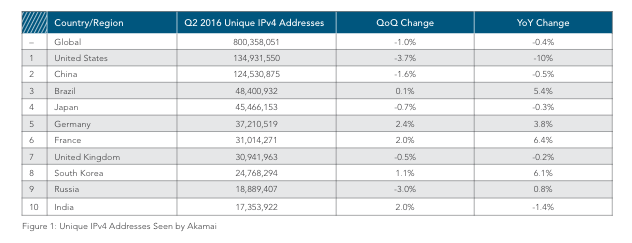Developers might not be impacted directly by new online trends and global connection speed changes, but a recent report by Akamai emphasized the influence the Internet has on developing applications.
Akamai, a content delivery network company, released its second quarter 2016 “State of the Internet” report that gathers data on connection speeds and the impact the Internet has on businesses. A majority of the report features global statistics, including connection speeds, broadband adoption metrics, notable Internet disruptions, IPv4 exhaustion and IPv6 implementation.
(Related: How developers can exploit the future of the mobile web)
The report highlighted global connection speed, stating it decreased 2.3% from the first quarter of 2016 to 6.1 megabits per second. (This was still a 14% increase year over year.) The average peak connection speed increased 3.7% to 36 megabits per second in the second quarter, rising 2.5% year over year.
The continued increase of speed is a reassuring trend for online retailers preparing for the holiday season. Developers should also consider changes in global connection speed, especially mobile speeds for their target audience, said the editor of the report, senior director of industry and data intelligence at Akamai David Belson. Global connection speeds can impact the quality of videos within applications, as well as things like multiplayer online games or the amount of data that an app might need to download.
“Similar consideration should also be given to fixed connection speeds; while Wi-Fi connections may run at higher speeds between the device (phone/tablet) and the router, that last-mile connection back to the ISP could be a bottleneck,” said Belson.
According to him, developers should not assume that users will always have Internet connections, nor should they assume that all users have access to high-speed Internet.
Belson said that developers should allow their applications to support IPv6 natively, since some network service providers are moving to only providing IPv6 addresses to end users, which means they are transitioning away from IPv4.
IPv4 exhaustion was another issue reviewed in Akamai’s report. This issue was identified at least 20 years ago, which drove the development of IPv6, said Belson.
“Due to the way that address space has been allocated over the years, available address space has largely been exhausted in most regions, meaning that networks/enterprises can either no longer obtain new IPv4 address space, or they need to buy it on the open market, potentially at significant cost,” he said.
Developers should test their applications to make sure they support both IPv4 and IPv6, and making the latter a requirement on the growing number of mobile network providers like Verizon Wireless, said Belson.
“They should also ensure that the applications they are developing are secure, taking the necessary steps to avoid exposing a user’s personally identifiable information, or having vulnerabilities that could be exploited, placing the user’s device at risk,” he said.







